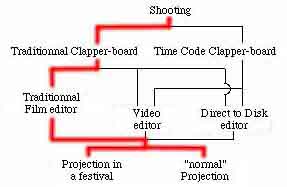|
Traditional Method (page 1) |
|
|
|
Traditional Method (page 1) |
|
|
Let's study the way films were made 40 years ago :
 |
Films like Ben Hur, Gone witht the Wind, 2001 : a
Space Odyssee...and thousands of others, have been shot with a traditional
clapper-board and edited on a film editor. Don't be afraid, I shall now explain... |
| First, let's describe a shooting in those days : |
| Since these two elements (picture and sound) are
recorded separately, a vocal announcement followed by a clapper-board
is performed at the beginning of each shot : this is called a "slate". The object of this slate is to systematically establish a sync point at the beginning of each take (or at the end of the take, if it isn't possible at the beginning. In that case, the clapper-board is held upside-down, so it can't be mistaken for the next shot's slate, when processing at the lab). We mean by "sync point" any related event, present on several media, which can be used to synchronize them. |
|
|||
| here, the slate would be "Piranha three, fifteen-b, take three" ended, of course, by the shutting of the clapper. | ||||
|
Picture process |
. |
Sound process |
|||||||||||||||||||||||||||
|
|
||||||||||||||||||||||||||||
|
As long as the sync sound of the shooting hasn't been synchronized to these pictures, the editor can no longer work. |
|||||||||||||||||||||||||||||
|
|
||||||||||||||||||||||||||||
| . |
It's now the sound editor's turn to have to wait for the editor to perform at least a basic cut of a scene to go on with his work |
||||||||||||||||||||||||||||
|